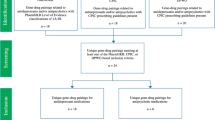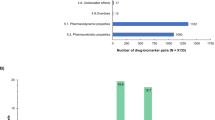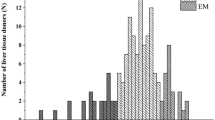Abstract
A retrospective pharmacogenetic study was conducted to identify possible genetic susceptibility factors in patients in whom the administration of the anti-Parkinson drug, tolcapone (TASMAR®), was associated with hepatic toxicity. We studied 135 cases of patients with elevated liver transaminase levels (ELT) of ≥1.5 times above the upper limit of normal, in comparison with matched controls that had also received the drug but had not experienced ELT. DNA samples were genotyped for 30 previously described or newly characterized bi-allelic single nucleotide polymorphisms (SNPs), representing 12 candidate genes selected based on the known metabolic pathways involved in the tolcapone elimination. SNPs located within the UDP-glucuronosyl transferase 1A gene complex, which codes for the enzymes involved in the main elimination pathway of the drug, were found to be significantly associated with the occurrence of tolcapone-associated ELTs.
This is a preview of subscription content, access via your institution
Access options
Subscribe to this journal
Receive 6 print issues and online access
$259.00 per year
only $43.17 per issue
Buy this article
- Purchase on SpringerLink
- Instant access to full article PDF
Prices may be subject to local taxes which are calculated during checkout



Similar content being viewed by others
References
Olanow CW . Tolcapone and hepatotoxic effects Arch Neurol 2000 57: 263–267
Spahr L, Rubbia-Brandt L, Burkhard PR, Assal F, Hadengue A . Tolcapone-related fulminant hepatitis Dig Dis Sci 2000 45: 1881–1884
Assal F, Spahr L, Hadengue A, Rubbici-Brandt L, Burkhard PR . Tolcapone and fulminant hepatitis Lancet 1998 352: 958
Schlappi B, Morimoto H, Kobayashi K, Horii I . Six-month oral toxicity study with tolcapone on beagle dogs Jpn Pharmacol Ther 1996 24: (Suppl) 77–102
Schlappi B, Jovanovic D, Okada M, Kobayashi K, Horii I . Six-month oral toxicity study of tolcapone in rat (feed admix) Jpn Pharmacol Ther 1996 24: (Suppl) 49–75
Jorga K, Fotteler B, Heizmann P, Gasser R . Metabolism and excretion of tolcapone, a novel inhibitor of catechol-O-methyltransferase Br J Clin Pharmacol 1999 4: 513–520
Clark AG . Inference of haplotypes from PCR-amplified samples of diploid populations Mol Biol Evol 1990 111: 22
Ciotti M, Marrone A, Potter C, Owens IS . Genetic polymorphisms in the human UGT1A6 (planar phenol) UDP-glucuronosyl-transferase: pharmacological implications Pharmacogenetics 1997 7: 485–495
Di Paola R, Frittitta L, Miscio G, Bozzali M, Baratta R, Centra M et al . A variation in 3’UTR of hPTP1B increases specific gene expression and associates with insulin resistance Am J Hum Genet 2002 70: 806–812
Lehnert V, Holzwarth J, Ott M, Thompson A, Demmak S, Foernzler D . A semi-automated system for analysis and storage of SNPs Hum Mutat 2001 17: 243–254
Germer S, Higuchi R . Single-tube genotyping without oligonucleotide probes Genome Res 1999 9: 72–78
Birch DE . Simplified hot start PCR Nature 1996 6581: 445–446
Longo MC, Berninger MS, Hartley JL . Use of uracil DNA glycosylase to control carry-over contamination in polymerase chain reactions Gene 1990 93: 125–128
Hoh J, Wille A, Zee R, Cheng S, Reynolds R, Lindpaintner K et al . Selecting SNPs in two-stage analysis of disease association data: a model-free approach Ann Hum Genet 2000 64: 413–417
Acknowledgements
We would like to thank all the patients that participated in this study and acknowledge the contributions of the study investigators who contacted the patients and collected the blood samples. These data were submitted to the European drug regulatory authorities (CPMP) on 15 July 2000. We would also like to thank the technical staff (T Burchill, J Mangaccat, R Olmos and Y Kidane) who ran the genotyping assays. Partial support through grant HG00008 (to JO) from the National Human Genome Research Institute is gratefully acknowledged.
Author information
Authors and Affiliations
Corresponding author
Rights and permissions
About this article
Cite this article
Acuña, G., Foernzler, D., Leong, D. et al. Pharmacogenetic analysis of adverse drug effect reveals genetic variant for susceptibility to liver toxicity. Pharmacogenomics J 2, 327–334 (2002). https://doi.org/10.1038/sj.tpj.6500123
Received:
Revised:
Accepted:
Published:
Issue date:
DOI: https://doi.org/10.1038/sj.tpj.6500123
Keywords
This article is cited by
-
Comparison of three human liver cell lines for in vitro drug-induced liver injury assessment: Huh7, HepaRG, and stem cell-derived hepatocytes
Molecular & Cellular Toxicology (2019)
-
Genetics and Treatment Response in Parkinson’s Disease: An Update on Pharmacogenetic Studies
NeuroMolecular Medicine (2018)
-
A systematic review and integrative approach to decode the common molecular link between levodopa response and Parkinson’s disease
BMC Medical Genomics (2017)
-
Are Polymorphisms in Genes Relevant to Drug Disposition Predictors of Susceptibility to Drug-Induced Liver Injury?
Pharmaceutical Research (2017)
-
Evolutionary Diagnosis of non-synonymous variants involved in differential drug response
BMC Medical Genomics (2015)



